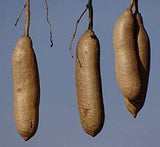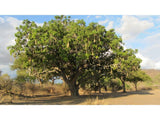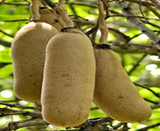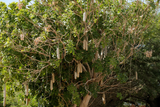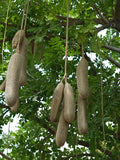Indigenous sausagetree
Scientific name: Kigelia africana, Sausagetree group (478)
English Name: Sausage tree
Local Name: Mufungufungu (B, L)
General information
Kigelia africana is a medium to large tree, up to 25m in height, with a dense rounded crown; bark grey, generally smooth in large specimens, flaking in thin, round patches. It grows in open woodland and in riverine fringes, it occurs at low altitudes.
Health benefits
Bark and leaves are used for bladder trouble/kidney disease, an enema or drink of the boiled root and stem bark for piles; wounds, sores and cuts are treated with a leaf and bark decoction or bark; bark and leaf extracts are used to cure snakebite. The unripe fruits are taken as a remedy for syphilis and rheumatism, and boiled fruit is massaged into the body for backache. The fruits are used to increase the flow of milk in lactating women. It is also used to treat dysentery and diarrhoea. The fruits and bark, ground and boiled in water, are taken either orally or as an enema in treating children’s stomach ailments. A cream made from fruit extract is used to remove sunspots particularly on the face and hands.
Human benefits
Slices of baked fruit are added to beer to help in fermentation of local honey beer. In times of food shortage, the seeds are roasted in hot ashes and eaten. Wood is moderately heavy. The wood is easy to work and produces a good-quality timber for general use. The sapwood is whitish or yellow and, although rather soft, has been used for planking, yokes, fruit boxes and shelving. Heartwood is light brown and is used for drums, utensils and cutlery. A black dye can be produced from the fruit. Tannin can be extracted from the roots and stem bark. With its fast growth rate, spreading canopy and interesting flowers and fruits, it is usually planted as a street tree.
Livestock benefits
The flowers and leaves eaten by livestock.
Farmer benefits
The large, maroon flowers attract bees and are a source of bee forage.
Planting and tree management
Kigelia africana is a relatively slow-growing tree. It can reach good proportions in 4-5years depending on the climate. The growth rate is at least 1m/year, but it is slower in colder areas. It is not frost resistant, but if young plants are protected for the 1st 2-3 years from cold winds in colder areas, they will survive.
Cultivation Detail
A plant of low to higher elevations in the tropics, where it is found at elevations up to 3,000 metres.It is found in areas where the mean annual rainfall is in the range 900 - 2,000mm.It is not frost resistant, but if young plants are protected for the first 2 - 3 years from cold winds in colder areas, they will survive
Prefers a medium loam soil Grows best in a sunny position in a fertile, humus-rich, well-drained soil .A very variable plant, a large number of species have been described by botanists, but it is now considered that the genus is monospecific and variations are due to ecological influences, affecting also phytochemistry.







